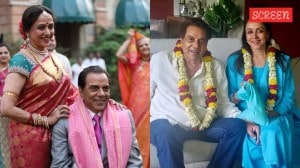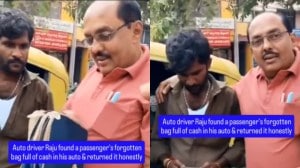Wounds of centuries healing: PM Modi at Ayodhya flag-hoisting ceremony; links Ram to nation-building
Democracy in our DNA, need to get rid of slavery mindset: Modi
 Prime Minister Narendra Modi and Uttar Pradesh Chief Minister Yogi Adityanath attending flag hoisting ceremoney of Ram Janambhoomi Temple in Ayodhya. (Express Photo Vishal Srivastava)
Prime Minister Narendra Modi and Uttar Pradesh Chief Minister Yogi Adityanath attending flag hoisting ceremoney of Ram Janambhoomi Temple in Ayodhya. (Express Photo Vishal Srivastava)Participating in the flag-hoisting ceremony at the Ram temple in Ayodhya, 22 months after he joined rituals for the consecration of the idol of Ram Lalla in the sanctum sanctorum, Prime Minister Narendra Modi said Tuesday that “centuries-old wounds are being healed, centuries of pain are finding respite, and a centuries-old resolve is attaining fulfillment today”.
The Prime Minister, RSS Sarsanghchalak Mohan Bhagwat and Uttar Pradesh Chief Minister Yogi Adityanath described the Shri Ram Janmabhoomi Mandir Dhwajarohan ceremony, symbolising completion of the construction of the temple, as the moment of “fulfilment” and “satisfaction” for all devotees.
Addressing the gathering, Modi linked Lord Ram to “rashtra” and gave a call for creating an India inspired by Ram Rajya.
“Aaj sampoorn Bharat sampoorn Vishwa Ram-may hai. Har Ram bhakt ke hriday mein aaj adwitya santosh hai, asim kritagyata hai, apar alokik anand hai. Sadiyon ke ghav bhar rahe hain, sadiyon ki vedna aaj viram pa rahi hai, sadiyon ka sankalp aaj siddhi ko prapt ho raha hai.”
(Today, all of India and the whole world are steeped in Ram. In the heart of every Ram devotee today, there is unique satisfaction, infinite gratitude, and boundless divine joy. Centuries-old wounds are being healed, centuries of pain are finding respite, and a centuries-old resolve is attaining fulfillment today).”
Hoisting the Dharma Dhwaja along with Bhagwat, Modi said, “This Dharma Dhwaj is not just a flag; it is the flag of the renaissance of Indian civilisation. Its saffron colour, the symbol of the Suryavansh (the Sun dynasty) inscribed on it, the Om word inscribed on it, and the Kovidara tree inscribed on it symbolise the glory of Ram Rajya.”
He said Ayodhya is the land where ideals transform into conduct. “When Shri Ram went into exile from Ayodhya, he was Prince Ram, but when he returned, he emerged as the most virtuous man. And in his becoming the most virtuous man, the knowledge of Maharishi Vashistha, the initiation of Maharishi Vishwamitra, the guidance of Maharishi Agastya, the friendship of Nishadraj, the affection of Mother Shabari, the dedication of devotee Hanuman — all these, along with countless others, played an important role.”
This collective power of society, he said, is also needed to build a developed India. He said he is happy that this “divine” courtyard of the Ram temple is becoming a place of consciousness of India’s collective strength.
Urging those visiting the Ram temple to also visit the temples of seven sages, he said, “These temples, along with our faith, also strengthen the values of friendship, duty and social harmony.”
He said it is important that everyone awakens the Ram within to ensure India’s development by 2047. “If India is to develop by the year 2047, if society is to become empowered, we must awaken the Ram within us… and what better day could there be than today for this resolve.”
He said there is a need for complete liberation from the mentality of slavery. Maintaining that while the country got freedom, it could not get over the mindset of slavery. This mindset, he said, was responsible for describing Lord Ram as “imaginary”.
“Kaha gaya humara samvidhan bhi videsh se prerit hai, lekin Bharat loktantra ki janani hai, loktantra humare DNA mei hai (It was said that the inspiration for our Constitution was foreign. But India is the founder of democracy. Democracy is in our DNA),” he said.
He said 190 years ago, in 1835, an Englishman named Thomas Babington Macaulay sowed the seeds of uprooting India from its roots. “Macaulay laid the foundation of mental slavery in India… In 2035, that unholy event will complete 200 years.”
He gave a call to pursue the goal of liberating India from the mentality of slavery in the next ten years. “The greatest misfortune is that the impact of what Macaulay envisioned has been far more widespread. We gained independence, but not freedom from the inferiority complex. A pervasive belief has crept into our country that everything foreign, every system, is good, while our own things are full of flaws,” he said.
Inscriptions in Tamil Nadu that are thousands of years old, he said, describe how democratic governance was run even in that period and how people elected the government. “But the trend has been to praise the Magna Carta.”
Giving a call “to create an India inspired by Ram Rajya”, he said it is possible “only when national interest comes before self-interest”.
“Hum nahi thhay, yeh desh tab bhi tha, hum jab nahi rahenge yeh desh tab bhi rahega. Humein door darshita ke saath kaam karna hoga (We were not here, yet this country existed; when we are no longer here, this country will continue to exist. We must work with long-term vision).”
“Humein apne bheetar Ram ko jagana hoga (We must awaken Ram within ourselves),”he said. “Humein woh Bharat banana hai jo Ram Rajya se prerit ho (We must create an India inspired by Ram Rajya).”
While it took 70 years to make India the 11th biggest economy of the world, he said that in the past 11 years, it had become the 5th largest economy. Soon, using the ideology of Ram, it would become the third largest in the world, he said. “Bhagwan Ram ke vichar humari prerna banenge (The ideals of Lord Ram will become our inspiration),” he said.







